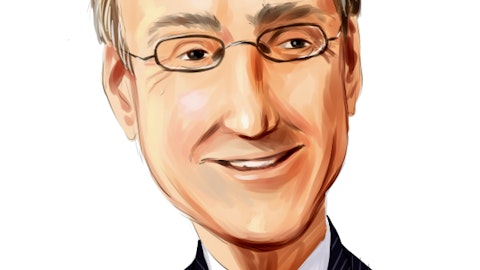Syneos Health, Inc. (NASDAQ:SYNH) Q4 2022 Earnings Call Transcript February 16, 2023
Operator: Good morning, ladies and gentlemen. Welcome to the Syneos Health Fourth Quarter and Full Year 2022 Earnings Conference Call. At this time, all participants are in a listen-only mode. Later we will conduct a question-and-answer session and instructions will be given at that time. I would now like to hand the conference over to Ronnie Speight, Senior Vice President of Investor Relations. Please go ahead, sir.
Ronnie Speight: Good morning, everyone. With me on the call today are Michelle Keefe, our CEO; Jason Meggs, our CFO; and Michael Brooks, our COO. In addition to the press release, a slide presentation corresponding to our prepared remarks is available on our website at investor.syneoshealth.com. Remarks that we make about future expectations, growth, trends, anticipated financial results and our expectations regarding transformation initiatives, expectations regarding the macroeconomic environment, the COVID-19 pandemic and the war in Ukraine constitute forward-looking statements for purposes of the Safe Harbor provisions under the Private Securities Litigation Reform Act of 1995 and we disclaim any obligation to update them.
Actual results may differ materially from those indicated by these forward-looking statements as a result of various important factors. These factors are discussed in the Risk Factors section of our Form 10-K for the year ended December 31, 2022, and our other SEC filings. During this call, we will discuss certain non-GAAP financial measures, which exclude the effects of events and transactions we consider to be outside of our core operations. These non-GAAP measures should be considered a supplement to and not a replacement for, measures prepared in accordance with GAAP. For a reconciliation of non-GAAP financial measures with the most directly comparable GAAP measures, please refer to the appendix of our presentation. I would now like to turn the call over to Michelle Keefe.
Michelle?
Michelle Keefe: Thanks, Ronnie. Good morning, everyone, and thank you for joining us today. As you saw in our release, our results this quarter came in as expected and in particular Commercial awards were strong. We remain keenly focused on transformation and are encouraged by customer feedback and are seeing the very early signs of improvement in Clinical awards and positive impacts from our investments. First, I want to start by resetting the stage for our key priorities and my expectations for the future of the company. Let me also underscore that customers remain our top priority and I continue to engage directly with them to ensure that we are exceeding their expectations. As a leadership team, we are laser focused on driving transformation across the business with a particular concentration on Clinical operations, business development and cost structure realignment.
We are also investing in retaining and strengthening our talent and prioritizing how we resource projects to ensure optimal delivery on customer commitments. While these investments will continue to suppress margins in the near-term, I firmly believe this is a responsible approach to reestablishing our competitive strength in Clinical and building a foundation for long-term success. I would now like to review our results and discuss our demand drivers and net awards. Total company revenue declined by 1% for the fourth quarter compared to the prior year, while growing 1.7% on a constant currency basis. Clinical Solutions revenue declined 2.1%, primarily due to lower net awards and the impact of foreign exchange, partially offset by higher reimbursable expenses.
Excluding reimbursable expenses and on a constant currency basis, Clinical Solutions revenue declined 0.8% due primarily to lower net awards and backlog conversion delays, largely offset by growth in our large pharma business, including FSP. Commercial Solutions revenue grew by 2.5% compared to the fourth quarter of 2021, driven by high — higher reimbursable expenses and growth in Deployment Solutions. Excluding reimbursable expenses and on a constant currency basis, Commercial Solutions revenue increased 0.5%, driven by Deployment Solutions, primarily due to the contribution from the Syneos One portfolio. Our Commercial business continues to perform in line with expectations, although growth has slowed over the course of 2022 as the macro environment began to impact our SMID customers, particularly in communication and consulting.
Now let’s review our demand drivers. In Clinical large pharma, although we remain underweight in this segment, we are encouraged by progress on several new opportunities, particularly in top 20 pharma. In fact, we recently expanding a top 10 former relationship into a sixth preferred provider strategic relationship where we are now the lead of two providers across their portfolio, after helping them design an outsourcing model to consolidate 60-plus regional vendors into two global providers. While we do not expect this expanded relationship to have a material near-term impact on awards and revenue, this is an important example of how our new customer engagement approach, developing fit-for-purpose solutions with dedicated leadership is resonating.
Our existing preferred provider relationships also remain healthy. Although, we continue to see slower pipelines as these customers assess their R&D spending and Clinical outsourcing strategies. We anticipate incremental new awards from these customers over the course of 2023 weighted towards the second half of the year. With our existing Clinical SMID customers, we are beginning to see the very early returns on our operating model and business development investments. While RFP flow from these customers remains down on a TTM basis, fourth quarter RFP flow was at its highest level since Q3 of 2021 and included more high value opportunities. Additionally, we are beginning to see other early signs of improvement as our win rate with repeat customers increased compared to the third quarter, an important indicator of customer satisfaction.
However, we still have work to do to improve our overall win rate amongst SMID customers. We also recently won a preferred provider relationship with a larger SMID customer that has already generated multiple RFPs for early phase studies with future late-stage opportunities expected. While these early indicators have not yet materially impacted overall SMID awards, they reinforce our confidence that our investments will continue to drive a gradual recovery. Although we are encouraged by this progress, Clinical net awards for the fourth quarter continued to be impacted by the dynamics that affected us in the third quarter, including cancellation activity within our normal range. This resulted in a book-to-bill ratio of 0.39 times, excluding reimbursable expenses and 0.77 times on a TTM basis.
We have factored these recent trends in RFP flow and awards into our 2023 outlook for the Clinical business. The Commercial team produced the second highest quarter of net awards in our history, with a book-to-bill ratio of 1.43 times for the quarter and 1.05 times on a TTM basis, excluding reimbursable expenses. While the Commercial demand environment remains relatively healthy, we have seen some softening among our large pharma customers, where RFP flow remains up on a TTM basis, but has slowed sequentially. We believe this impact is temporary as these customers evaluate the allocation of their commercialization budgets in light of the Inflation Reduction Act, while looking for innovative commercial models to enhance efficiency. We have also continued to see slower TTM RFP flow from SMID customers, primarily attributable to the macroeconomic environment.
These recent trends were factored into our 2023 outlook for the Commercial business. Now I will provide an update on the two primary areas of investments we highlighted last quarter. First, we are making progress on transforming our Clinical operating model. In recent months, we have streamlined our organizational structure, consolidating roles and simplifying processes that provide an improved experience for customers and employees, while allowing us to better deploy fit-for-purpose solutions specific to each customer’s needs. Foundational to these improvements have been investment and accelerated development of Clinical development tools and data applications, ranging from statistical modeling for site performance and enrollment to use of AI machine learning to better detect risks and issues.
These investments are closing competitive gaps and showcasing our differentiators and proposals and bid defenses. For example, we recently won an opportunity that leveraged our statistical tools for site and enrollment modeling and feature compelling solutions for engaging patients and healthcare providers made possible by the unique blending of our Clinical and Commercial capabilities, all under the direction of trusted therapeutic experts. We believe further wins will materialize as we fully deploy these tools into our therapeutic areas and mature unique combinations of technology, data and Clinical to Commercial capabilities. We are also deploying a high-touch global to local country model for site and patient related activities, more effectively leveraging local knowledge about regulatory requirements, standards-of-care and site performance, while maintaining global standards of best practices.
Coupled with the Clinical development tools and applications I mentioned, our operating model is showing early signs of delivering more streamlined and automated startup, improved enrollment productivity, high quality data and an improved experience for sites, customers and employees. This new model has generated very encouraging feedback from customers and we expect its integration across our portfolio to be largely complete for new customers during the first half of 2023. Clinical employee retention is also turning at a two-year high, providing strong continuity for customers and enabling us to build momentum and operating performance, customer engagement, and ultimately, backlog conversion and net awards. We believe these investments in technology, the integration of Clinical and Commercial capabilities as bundled solutions to support better protocol design, faster enrollment and improved patient outcomes and strengthening our heritage of scientific and therapeutic expertise will be important factors in driving new business and long-term growth.
Our second area of focused investment is the transformation of strategic business development with Christian and his leadership team working closely with Michael and our operations teams to drive enhanced customer engagement. We continue to expand our BD talent, hiring seasoned veterans with relationships that are already bringing new opportunities. Clinical expertise is ultimately the key to customer’s decision-making process and we are expanding our therapeutic and scientific talent and bringing these leaders to the forefront of customer solutions to improve our delivery, account development and sales activities. Further, we have established dedicated organizations and leadership aligned to each large pharma partnership across full service and FSP enabling consistent, quality and efficiency, while allowing us to quickly adapt to each customer’s evolving outsourcing strategies.

Photo by Lucas Vasques on Unsplash
Another important aspect of driving Clinical awards is more fully leveraging our Commercial and Consulting expertise for account management, win strategy and sales enablement. To this end, we have increased the participation of our Syneos One Group to support customers with asset development and prioritization, funding strategies and shaping their Clinical outsourcing models. Based on recent engagements and awards, this expanded consultative approach is already creating more high value Clinical opportunities. Combined with the progress on our Clinical operating model, over time we expect our improved business development approach to increase win rates with new customers, while also generating incremental repeat business opportunities. We have also evaluated our cost structure to align with our current business and the evolving demand environment and to drive efficiencies, while continuing to invest and position our organization for long-term success.
I have decided to consolidate and integrate the various strategic projects underway within the company, including ForwardBound, Unify and Clinical Reimagined under Project Velocity, a single transformational effort that will bring value to customers and employees and drive long-term margin expansion. This combined initiative will be led by senior management and reports directly to me. Jason will provide further details, including how these initiatives will ramp and impact guidance. In summary, we believe the programs I have discussed will yield benefits through improved quality and scalability, while driving long-term margin expansion, enabling us to best serve customers and enhance performance over time. We remain confident in our strategy and senior leadership is relentlessly focused on this ongoing transformation to best position Syneos Health to capitalize on a compelling long-term market opportunity.
As this will be Jason’s last earnings call as CFO, I want to recognize and thank him for his dedication and contributions to Syneos Health over the last nine years, including nearly five years as CFO. We are all incredibly grateful for his commitment and leadership and we wish him the very best. Jason?
Jason Meggs: Thank you for the kind words, Michelle, and good morning, everyone. It has been an honor and a privilege to work at Syneos Health, particularly for these past five years as CFO. I have been supported by a great team and I am thankful to each of them and very proud of what we have accomplished together. With that, let me turn to our results. Total revenue for the fourth quarter of 2022 was $1.36 billion, down 1% as reported and up 1.7% in constant currency compared to 2021. Excluding reimbursable expenses and on a constant currency basis, revenue declined 0.4% compared to the fourth quarter of 2021. Clinical Solutions revenue for the fourth quarter was $1.02 billion, down 2.1% as reported and up 0.7% in constant currency compared to 2021.
Excluding reimbursable expenses and on a constant currency basis, Clinical Solutions revenue declined 0.8% versus the fourth quarter 2021, driven primarily by lower net awards and backlog conversion delays, largely offset by growth in large pharma. Clinical revenue was above our expectations during the fourth quarter, primarily due to higher reimbursable expenses and foreign exchange. Total as reported Clinical revenue includes an 80-basis-point tailwind from reimbursable expenses. Fourth quarter Commercial Solutions revenue was $336.6 million, up 2.5% or 4.8% in constant currency compared to 2021. Excluding reimbursable expenses and on a constant currency basis, Commercial Solutions revenue increased 0.5%. Growth in Commercial revenue was driven by Deployment Solutions, primarily due to the contribution from our Syneos One portfolio.
This growth was partially offset by headwinds in communications and consulting. Commercial revenue for the fourth quarter was above our expectations due to higher reimbursable expenses and foreign exchange. Total as reported Commercial revenue growth also included a tailwind of 450 basis points from reimbursable expenses. It is important to note that reimbursable expenses were higher than anticipated in quarter four, primarily due to two fast burning reimbursable expense heavy projects that ramped quickly. One project is in Clinical and one is in Commercial, and the reimbursable expense burn will continue to impact the first half of 2023. Adjusted EBITDA for the fourth quarter decreased 11.8% to $209.1 million, representing an adjusted EBITDA margin of 15.4%, a decline of 190 basis points compared to the fourth quarter of 2021.
The decrease in adjusted EBITDA margin for the fourth quarter was primarily the result of less favorable revenue mix, including reimbursable expenses and our investments. Fourth quarter adjusted EBITDA margin was below our expectations due to the impact of a less favorable revenue mix, primarily reimbursable expenses and foreign exchange. For the full year 2022, adjusted EBITDA increased 4.6% to $800.8 million. This represents 14.8% adjusted EBITDA margin and year-over-year expansion of 10 basis points. Excluding the impacts of higher than anticipated reimbursable expenses and incremental foreign exchange in Q4, margin expansion was 40 basis points. Adjusted diluted EPS of $1.23 for the fourth quarter declined 16.9% year-over-year, driven by the decline in adjusted EBITDA and higher interest and depreciation expense, partially offset by lower share count and tax rate.
Full year 2022 adjusted diluted EPS was $4.72, up 5.8% from 2021. Operating cash flow was healthy at $123.8 million for the fourth quarter and $427 million for the full year. Operating cash flow for the full year declined primarily due to increased DSO, coupled with higher cash taxes and interest. DSO increased from the prior year primarily due to higher concentration of accounts receivable and larger pharma customers, included the related timing of billing and collections. Capital expenditures were $23.6 million for the fourth quarter and $93.5 million for the full year, primarily due to increased strategic investments in data, technology and analytics platforms to support our operations. During the quarter, we expanded our accounts receivable securitization facility by $150 million, extended the maturity until October 2025 and voluntarily prepaid the same amount of our Term Loan A.
We also refinanced our primary credit facilities, expanding our revolving credit facility from $600 million to $1 billion to increase available capacity, while extending maturities to November 2027. The full Term A facility and $261 million on the revolver were drawn at the closing to pay off the previous term loan. Finally, we subsequently repaid an additional $140 million of our revolving credit facility. These transactions resulted in debt outstanding at year-end of $2.69 billion. Combined with unrestricted cash of $111.9 million, net leverage at the end of the quarter was 3.2 times. When our current interest rate swap matures at the end of Q1, we plan to continue to hedge a portion of our floating interest rate exposure with the target of making 45% to 55% of our debt effectively fixed rate.
We expect this to provide some additional certainty around anticipated interest expense for 2023 as market conditions continue to fluctuate. Our non-GAAP effective tax rate for the fourth quarter was 21.5%, bringing our effective tax rate for the full year down to 23%, driven by increased research and development credits, and a lower state tax rate. Before turning to guidance, I want to provide more details on the consolidated initiatives Michelle highlighted. Our near-term cost management efforts include right-sizing and realigning our workforce, while streamlining our organizational structure. We are also convincing our global facilities footprint, while deploying new approaches for local employee engagement that better align to a hybrid work environment.
Our longer term initiatives are expected to include partnering on certain functions, while utilizing our transformation and technology partner to drive innovation and automation across our business. In aggregate, we expect these activities to result in initial cost savings of $30 million to $40 million in 2023, net of funding the investments we have highlighted. We expect these net savings to increase to $100 million to $150 million in 2024, as Velocity activities continue to ramp up. To fuel these initiatives and investments this year and beyond, we expect to incur significant restructuring, transaction and integration costs as reflected in our guidance. Turning now to our 2023 guidance. Our guidance contemplates our current view of the estimated impacts of ongoing economic and geopolitical developments, and reflects foreign exchange rates as of February 13th.
We expect total revenue of $4.98 billion to $5.18 billion, representing contraction of 7.8% to 4%, including a foreign exchange headwind of $10 million. This includes an estimated net headwind of 100 basis points from reimbursable expenses. We expect our total adjusted EBITDA to range from $675 million to $725 million. This reflects an adjusted EBITDA margin of 13.6% to 14%, down approximately 100 basis points from 2022 at the midpoint. Lastly, we expect adjusted diluted EPS to range from $3.26 to $3.53, representing year-over-year decline of 30.9% to 25.2%. Our adjusted diluted EPS guidance includes interest expense of $139 million to $149 million, an increase of $63.2 million over 2022. This is based upon current market forecasts and reflects the maturity of our current interest rate swap on March 31st.
Our adjusted diluted EPS guidance also assumes a non-GAAP effective tax rate of 23.5%, a 50-basis-point increase over 2022, driven by an increase in the U.K. tax rate. Our guidance also reflects an estimated diluted share count of 104.8 million shares. We expect our net cash outlay for income taxes during 2023 to be approximately $50 million to $55 million. We expect first quarter revenue of $1.26 billion to $1.31 billion and total adjusted EBITDA of $136 million to $148 million. This reflects a revenue decline of 5.7% to 2%, and adjusted EBITDA decline of 21.7% to 14.8% compared to the first quarter of 2022. This revenue guidance includes a foreign exchange headwind of $17 million. Importantly, FX has the most significant impact on the first quarter as it changes to a tailwind during the second half of the year.
This revenue guidance also reflects a tailwind of approximately 200 basis points due to reimbursable expenses, largely driven by the projects that impacted us in the fourth quarter. The reimbursable expense tailwind attributed to those projects results in a year-over-year headwind of 50 basis points to our adjusted EBITDA margin. In addition to Q1 being a seasonally low margin quarter, the investments we have highlighted will impact Q1 more heavily while the benefit of our savings initiatives will ramp throughout the year. Finally, assuming Clinical net awards and backlog burn rate recovered during 2023 as reflected in our guidance and we do not experience further deterioration in the macroeconomic environment, we expect low single-digit revenue growth in 2024.
Given this revenue profile, the 2023 adjusted EBITDA margin reflected in our guidance, our investments and increased savings initiatives, we currently expect a rebound in adjusted EBITDA dollars to a level comparable to 2022. I am now going to turn it back over to Michelle for some final comments. Michelle?
Michelle Keefe: I am encouraged by the customer feedback on our enhanced operating model and differentiated strategy. In closing, I want to stress our continued focus on excellent delivery for our customers as the foundation for our future success. Our investments and other initiatives I discussed are designed to further accelerate our strategy, enhance the scalability and efficiency of our operations and drive new business awards. I want to thank all of my Syneos Health colleagues around the world for their energy and collaboration and is only together can we achieve the highest performance for our customers. I am proud of our ongoing transformation, our culture and the positive impacts we have on patients around the world. This completes our prepared remarks and we will be happy to answer any questions. Operator?
See also 10 Hot Insurance Stocks To Buy Now and 15 Best Dividend Leaders to Buy.
Q&A Session
Follow Syneos Health Inc. (NASDAQ:SYNH)
Follow Syneos Health Inc. (NASDAQ:SYNH)
Operator: Thank you. And our first question coming from the line of Patrick Donnelly from Citi. Your line is open.
Patrick Donnelly: Hey, guys. Thank you for taking the questions. Michelle, maybe one — on one of the comments you made there. I think it was on the Commercial piece, just in terms of large pharma, maybe taking a little closer look at things kind of given the IRA. Can you just talk about what you are hearing from them, it’s definitely an interesting comment, I know it’s come up a few times under other peer calls as well? What the commentary is there? What the impact could be? And again, how much more deliberate are they being with kind of the spend and thought process given this new act out there?
Michelle Keefe: Patrick, thanks for the question. So our large pharma trailing 12-month RFP flow is up high-single digits but we have seen it sequentially slowing down from Q3 to Q4. And when we have these conversations around the macro environment and the Inflation Reduction Act, we are hearing they are just being really purposeful in looking at their portfolios, seeing where they want to invest in the portfolios based on the potential impacts of the IRA down into 2025. They know what the list of products are in 2025 and they are thinking through based on the portfolios they have or their business development activities, what types of products do they want to invest in, in the future. The good news is we are part of those conversations and our teams — we actually have a team that does a lot of work around this in partnership with pharma companies.
And so we think it’s temporary, we think as they think about their new Commercial models, how those models become more efficient in driving profitability of the assets they have today, as well as planning for what they are thinking about doing tomorrow, we think we are part of that solution and can take advantage of that, but we do see it slowing some of the decision-making right now for sure.
Patrick Donnelly: Okay. That’s helpful. And then maybe just on the Clinical side, bookings obviously remained a little bit soft in terms of the book-to-bill, but it sounds like you have had some at least signs of life with customers and customer conversations and are feeling like there’s a potential inflection of assortment. Can you just give us any metrics you have around kind of what gives you some confidence that that booking number is going to come back again, the book-to-bill can firm up a little bit? And then similarly on that IRA piece, is there a potential for that to impact Clinical down the road, just your perspective there would be helpful as well? Thank you.
Michelle Keefe: Sure, Patrick. So we have seen some green shoots. There are some very early indicators for Clinical awards. We did see an improvement in repeat customers that, as you know, we talked about that last quarter as really important to us as a measure. So we did see improved awards with repeat customers. We have seen our SMID RFP pipeline improved significantly. I think it’s the second highest SMID RFP flow that we have seen in Q4. We also had a really important win which was we had our sixth preferred providership for Clinical added. So we are excited about that. And there’s some really — we did some really innovative things there in regards to how we used our consulting team to partner with our Clinical operations team along with senior leadership, working on how to really consolidate 60 plus vendors and FSP down to global providers.




